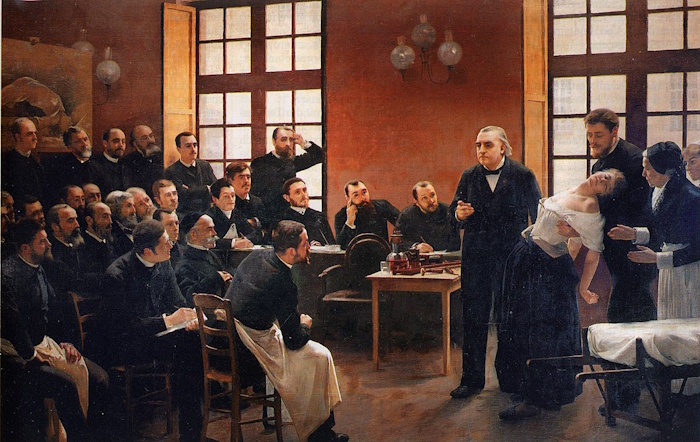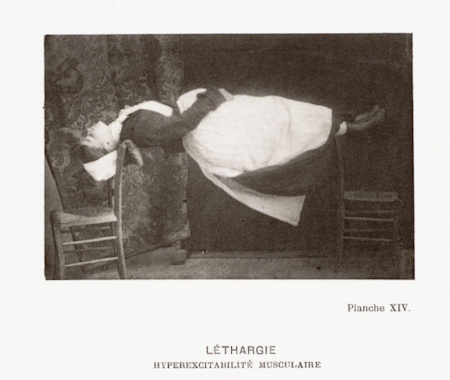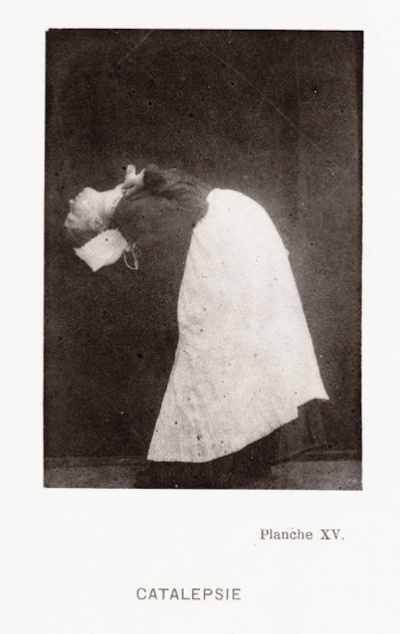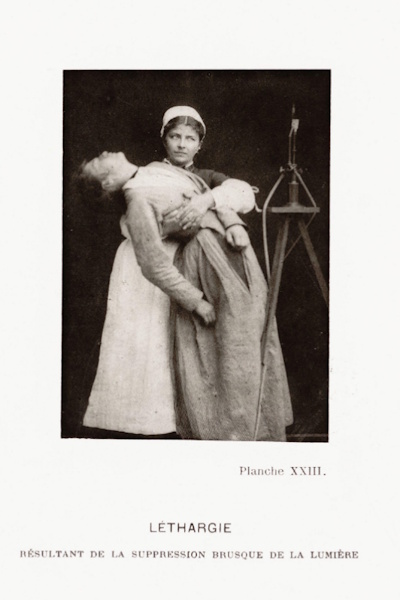

André Brouillet - A Clinical
Lesson at the Salpêtrière
Iconography of the Salpêtrière
Hospital
‘Father of neurology’, Charcot (1825-1893) identifies a new
disease: ‘hystero-epilepsy’.
I - Charcot Presents Hysteria
Immortalised by Brouillet in oils,
dark-garbed Charcot holds court
to the great, the good, the eminent
men of Paris, Vienna, seats of power,
exhibits an ‘hysteric’, white-clad,
swooning, her corset loosening,
shoulders rising erotic from the foamy
petticoat. The sober-suited men
are serious, observe, reflect,
mark the female as sensual
embodiment of her afflictions.
II - Playing to the Gallery
He shows me off, puts me under,
uses his huge tuning-fork.
Observe, gentlemen, the pronounced
impact of sustained sound on the patient.’
He puts me through my paces, runs me
through the stages of my illness.
I perform - as I must - the full range:
tear at my clothes and my flesh,
roll my eyes white, loll my tongue
one way, then another, bend my body
right back, act out the menace
of my ‘condition’…I look sideways
at the audience, some women
there, too, fine feathers, they! On the gad.
‘Observe, gentlemen, the unnatural
contortions of the spine, the facial convulsions.’
I breathe deep, sigh and sink, weak,
against the assistant, kind woman.
I play faint for them, hysterical,
plead with my arms, raise my skirts
high above my shift, beseech love,
grinding and swaying my hips.
(Easier than bearing Louis’s weight
and force and violence,
this acting out, this play.)
‘Observe, gentlemen, the successive phases, in sequence, of her
malady.’
My last act is the crucifixion,
hold my stiff arms and form a stiff cross,
hold it, hold it, hold it…. hold it
until he gives the sign.
The audience clap, respectful,
mouth to each other in wonder.
They must admire him, of course, but
how dare they pity me.
III - ‘Here comes the little man with
his mischief box!’
De Boulogne comes to take photographs,
charts scientifically the sufferings
of women held in the Salpêtrière,
explosive place of illness: dementia,
idiocy, erotomania, melancholic
catalepsy, paralysis, lethargy,
epilepsy. And megalomania.
The prisoners of Salpêtrière, their white arms
reaching through the bars of stone cells, call out
to him in mockery. Ribald, they deride
the size of his equipment, ask if he
is a real man. The laughter of these women
rings out freely, wild, coarse and crude, echoes
through the asylum corridors. An outlet.
Charcot relies on these photographs, ‘perfect
extension of the clinician’s eye’. He is poised
at the confluence of science, religion, art.
Does he ever doubt his truth, question truly
if his patients are ill - or fictionalised
victims of maladies observed, diagnosed
and birthed by him and his doctors?
IV - Plate XIV - Observation

Twelve small photographs in sepia,
or maybe faded monochrome,
they evoke Victorian pornography,
images passed from grubby hand
to grubby hand, behind closed doors.
Assembled, four by three, they form
a stuttering narrative sequence,
as the slender white fish of the naked
body of a woman slips and flops
on a brass bedstead. Hands secured,
she arches her back in languor
or in ecstasy – or agony.
Does she evade or court the camera?
The doctors watch her slender frame,
ribs like bars, her shallow pelvic bowl,
triangle of dark hair at her groin,
her legs splayed as she writhes her body,
creates the ‘arc en cercle’ of the hysteric.

V - Plate XV – Case Study in Muscular
Hyper-Excitability
A woman floats - luminous white
against the darkness, head bent
back, eyes turned upwards, but closed.
This image evokes séances, witchcraft,
supernatural, female strangeness.
In truth, her tensed body is so stiff,
she is a board between two chairs.
Her demure hands are clasped tight
on her belly, over her ovaries,
pressing them down, making them
submissive, as she is, for the camera.

VI - Plate XXIII – ‘a gifted hysteric’
Augustine gives him exactly
what he wants. Allows him
to pose her, fix her image
in the hysteric’s different states:
eroticism, menace, lethargy.
A haunch of meat, a slab of flesh
in some medieval shambles, she
is as naked as grave Charcot
is overdressed. Or wears a white shift
that drifts from her shoulders, rides up
her legs, reveals decolletage
and rounded thighs, her arms outstretched
in gentle beatific attitude.
They work, doctor and patient
in fecund collaboration,
to fetishise the female body,
identify the pandemonium
of women’s infirmities.
VII
Legacy
‘Napoleon of the Salpêtrière’,
Charcot makes his name, leaves his gifts
to science, to male posterity.
Her charms failed, utility
diminished, Augustine smashes
windows, screams, shreds
the strait-jacket they make her wear.
Escapes - disguised in male attire.
Amanda Brookfield
If you have any thoughts about this poem, Amanda Brookfield
would be pleased to hear them





